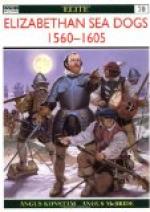The ‘mosquito’ fleet of Henry’s time was represented by ‘row-barges’ of his own invention. Now that the pinnace was growing in size and sail power, while shedding half its oars, some new small rowing craft was wanted, during that period of groping transition, to act as a tender or to do ‘mosquito’ work in action. The mere fact that Henry VIII placed no dependence on oars except for this smallest type shows how far he had got on the road towards the broadside-sailing-ship fleet. On the 16th of July, 1541, the Spanish Naval Attache (as we should call him now) reported to Charles V that Henry had begun ’to have new oared vessels built after his own design.’ Four years later these same ’row-barges’—long, light, and very handy—hung round the sterns of the retreating Italian galleys in the French fleet to very good purpose, plying them with bow-chasers and the two broadside guns, till Strozzi, the Italian galley-admiral, turned back on them in fury, only to see them slip away in perfect order and with complete immunity.
By the time of the Armada the mosquito fleet had outgrown these little rowing craft and had become more oceanic. But names, types, and the evolution of one type from another, with the application of the same name to changed and changing types, all tend to confusion unless the subject is followed in such detail as is impossible here.
The fleets of Henry VIII and of Elizabeth did far more to improve both the theory and practice of naval gunnery than all the fleets in the world did from the death of Drake to the adoption of rifled ordnance within the memory of living men. Henry’s textbook of artillery, republished in 1588, the year of the Armada, contains very practical diagrams for finding the range at sea by means of the gunner’s half circle—yet we now think range-finding a very modern thing indeed. There are also full directions for making common and even something like shrapnel shells, ‘star shells’ to light up the enemy at night, armor-piercing arrows shot out of muskets, ‘wild-fire’ grenades, and many other ultra-modern devices.
Henry established Woolwich Dockyard, second to none both then and now, as well as Trinity House, which presently began to undertake the duties it still discharges by supervising all aids to navigation round the British Isles. The use of quadrants, telescopes, and maps on Mercator’s projection all began in the reign of Elizabeth, as did many other inventions, adaptations, handy wrinkles, and vital changes in strategy and tactics. Taken together, these improvements may well make us of the twentieth century wonder whether we are so very much superior to the comrades of Henry, Elizabeth, Shakespeare, Bacon, Raleigh, and Drake.
BIBLIOGRAPHICAL NOTE
A complete bibliography concerned with the first century of Anglo-American affairs (1496-1596) would more than fill the present volume. But really informatory books about the sea-dogs proper are very few indeed, while good books of any kind are none too common.




